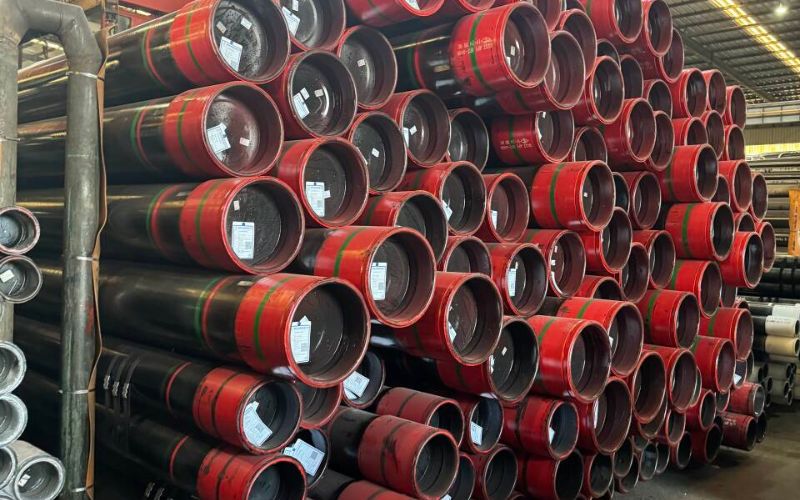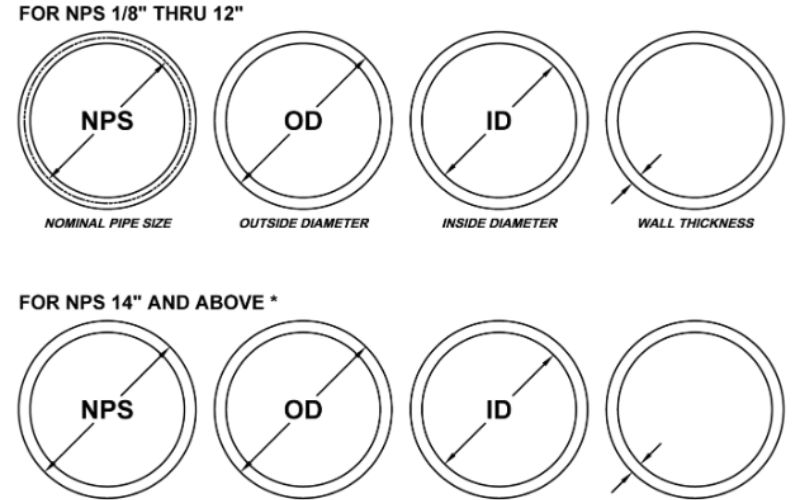End caps with steel components are majorly used in the protection and longevity of exhaust, pipe, tube, as well as other systems in a range of industries. Also known as the anti-roll dome nuts, such cap nuts are very small, but they are used to protect the piping and tubing contents or media from getting contaminated and/or damaging the pipe or tube itself. Nonetheless, with so many caps available how can one have the best selection. Where do you start as far as a choice of steel end caps best suitable for your needs? This article seeks to explore in detail these reasons, the assumptions, and the best practices used in the use of steel end caps. This paper will provide all the information necessary for you to improve the service life of pipes or ensure safety, or meet the stated standards. Further in this article, you will learn why it is important to use the correct steel end caps because they strengthen the protective system of the conduit.
What is a steel end cap and why is it important?
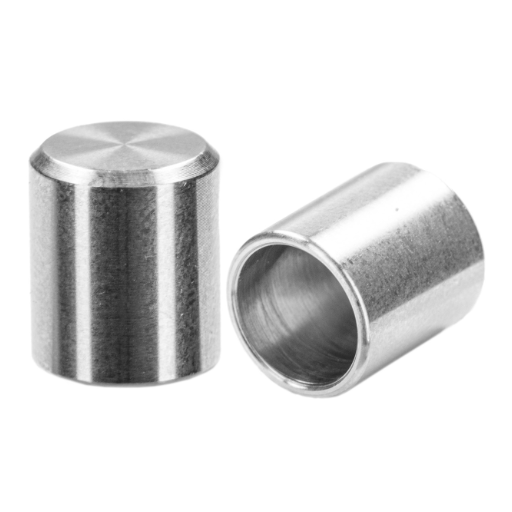
A steel end cap is a structural element that serves to securely fasten the end of a pipe. It has the capacity to prevent the entry of dust, pollutants, or even moisture into the pipe, this at the same time emphasizes as liquid or ash discharge protection. Steel end caps are very important solution especially in relation to security of pipelines, their operability improvement and user’s safety in building and construction industry. It ensures excellent HVAC (heating, ventilation and air conditioning) installation hot water supply and pipe layout cooling systems remain hygienic and work ceteris paribus. Their design and resistance to corrosion allow them to be used in hard wearing applications in such a way that other construction materials are unnecessary.
Understanding the function of an end cap
It is well known that industrial sectors especially in construction and engineering rely on end caps to add a vital crucial note to the constituent elements of equipment and structures. In fact, the very fact of the problem lies in placing the caps at the end of pipelines and ensuring there are suitable measures to avoid any environmental and operational stress on the pipes. In the oil & gas, chemical and petrochemical and water and wastewater industries, steel end caps are invaluable because they reduce the risks of leakage as well as contamination hazards.
An exposition of statistics inform the readers that even today, corrosion resistance is the most desired property of end caps and that there are stainless steel types which contribute the most to the value targets due to the necessity of steam service. A study on their use suggests that such level capabilities of stainless steel end caps are applicable even in areas with pressure above 800 degrees thermal capacity services. Further, this product has been afforded additional strength improvement between fifteen (15) and twenty (20) percent in the last ten years including cutting down on maintenance costs and the loss of revenue thanks to those in pipeline operation.
Meanwhile, in line with safety measures and social responsibility on the part of the manufacturer, it is critical for end caps to seal the pipeline completely during use to prevent any hazardous materials from leaking out and causing harm to those individuals involved and the surrounding area. Further, these designs also consider developments in threading and welding procedures that will result in more effective joining of tubes even where the tubes are of different diameters and are made of different materials. At the same time, these changes reflect ongoing policies that call for solutions that are adequate, sustainable, and economical in an environment where demand far outweighs supply.
Benefits of using steel for pipe end protection
Steel is the material of choice when it comes to the protection of pipe ends due to reasons that pertain to its attribute of being long lasting, its adaptability to different uses, and its inability to break easily. Any sector, whether gas and oil or construction and others, that requires the use of materials at one point or another, will not miss out on the benefits associated with prevailing strength. Reports indicate that due to the content and construction, without damage’s fatigue limit value, the tensile strength of steel will range somewhere between 250MPa to even beyond 500 MPa which also exceeds metals that are stronger than steel thus making steel the most preferable metal when it comes to the protection of the ends of tubes and pipes from mechanical impact damage.
Still, there’s a more critical benefit that link much more to the usage of steel and that is its wear and long term weathering capabilities. Latest generations of allied coatings such as Galvanized or Stainless steel tend to have better corrosion resistance that signifies their usage well in pipes placed in humid areas or chemically treated environments for further usability of the structure. Consequently, some data points out that some stainless steel grades can stand up to tens of years of harsh than normal operational conditions — thereby, averting the need for regular servicing plus avoiding production loss.
In addition, steel is also quite versatile allowing the provision of pipe end caps with a range of diameters and applications. This is as a result of advanced welding techniques available that make it possible to provide complete pipe joints which prevents escape of substances and manner which can be hazardous. Owing to this and steel’s eco-friendliness to the surrounding environment, as well as costs, it will be seen that there are suitable aspects in terms of engineering today where steel can be used that can be termed as ecologically friendly.
Common applications of steel end caps
Steel end caps play a critical role in various industrial and commercial applications, offering durability and reliability under demanding conditions. Below are some of the most common uses:
- Oil and Gas Industry
Steel end caps are essential in pipelines used for transporting crude oil, natural gas, and refined products. Their superior structural integrity ensures secure sealing, which is crucial for preventing leaks and environmental contamination. With pipeline projects often spanning thousands of miles, steel end caps meet rigorous standards to handle high pressure and temperature variations.
- Water and Wastewater Systems
These end caps are widely used in municipal water treatment plants and industrial wastewater systems to seal pipes efficiently. Their corrosion resistance ensures long-term durability, even when exposed to chemicals and other aggressive substances, reducing maintenance costs.
- Construction and Infrastructure Projects
End caps are used in structural steel applications, such as in bridges, skyscrapers, and tunnels, where closed pipe sections contribute to building stability. They also cap structural tubing in architectural designs, enhancing both functionality and aesthetics.
- Chemical and Petrochemical Processing
Steel end caps are vital in chemical plants and refineries, offering a secure solution for handling hazardous chemicals at high temperatures and pressures. Stainless steel variants, in particular, are preferred for their ability to resist corrosion from chemicals like acids and alkalis.
- Energy Production
Renewable energy systems, including hydropower and geothermal plants, rely on steel end caps to close pipe systems used for water transport and heat exchange. Their ability to withstand extreme conditions is critical for ensuring operational safety and efficiency.
- HVAC Systems
Heating, ventilation, and air conditioning systems often use steel end caps to seal ductwork and pipelines. The caps help maintain system efficiency and prevent air leakage, ensuring thermal regulation and energy savings.
- Automotive and Aerospace Engineering
Steel end caps find application in exhaust systems, hydraulic systems, and fuel lines, where secure, precision-engineered seals are required. Similarly, in aerospace technology, their resilience and lightweight designs make them indispensable in high-performance machinery.
- Food and Beverage Processing
For industries that demand hygienic and contamination-free production, stainless steel end caps are used in piping systems to transport liquids like milk, beer, and juices, adhering to strict health and safety codes.
How to choose the right steel end caps for your needs?
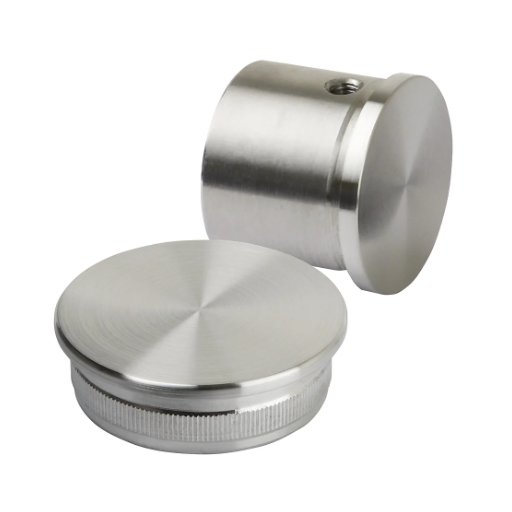
- Understand the Application
Identify where the steel end caps will be used—industrial systems, food processing, or high-pressure environments. This ensures you select caps with the appropriate material composition and durability.
- Check Material Compatibility
Ensure the steel grade is compatible with the substances it will come into contact with, such as corrosive liquids, gases, or food-grade items.
- Determine Size and Fit
Measure the pipe dimensions accurately and choose end caps that fit snugly to guarantee a secure seal and prevent leaks.
- Evaluate Pressure and Temperature Requirements
Select end caps designed to handle the operating pressure and temperature of your system for reliable performance.
- Certifications and Standards
Opt for end caps that adhere to relevant industry standards, such as ISO or FDA guidelines, for safety and compliance.
Factors to consider: size, diameter, and od
While choosing appropriate steel end caps, it is essential to understand the interactions between the sizes, diameter, and outer diameter of the caps so as to ensure the modifications are fully functional according to the interaction levels. The sizes may require consideration based on pipe or fitting size to do away with concerns such as leaks or improper fusion. Supposing a case-in-point, normalized sizes are mostly described in inches or millimeters, and they can be referred to as pipe diameter.
Diameter, a subset of which is the nominal diameter (ND), the inner diameter of the pipe or fitting works to be joined. Buttered measurements become, therefore, imperative to ensure that the performance of a device is built solidly into the structures they are meant to work with. For example, in situations where there is a high pressure, the absence of small clearances can lead to the occurrence of a catastrophic fault.
The outside diameter (OD) of a pipe is a measurement taken at the end cap and the pipe, or at one end of the pipe that has the cap. Such measurements for steel tubes, such as an OD of 12.75 inch (for NPS 12 pipe), which are identified particularly for the purpose of engineers or buyers are made to match industry requirements. In this respect, the OD is more pronounced because it helps in ensuring uniformity in the manufacture and use of different assemblies.
To avoid errors in measurement and ensure that the size information is consistent during procurement, use detailed sizing charts of industry-provided standards. In addition, strict consideration of construction material standards for gases and liquid products such as valid ASTM or the much appreciated ANSI B16.9, that assure perfect fit between pipe and bells, will result in better safety and longevity of the installation. Taken together with the application of the specific loads and temperatures of a program, these Basic Sizing and Serviceale Pressure and Temperature Ratings will deliver proper and safe utilization of the plant designed.
Choosing between round and square steel end caps
Choosing between round and square steel end caps depends on multiple factors, including functionality, application requirements, and design aesthetics. Round steel end caps are often preferred in systems where fluid dynamics play a significant role. Their streamlined shape minimizes turbulence and pressure drops, making them ideal for pipelines transporting liquids or gases. Additionally, the lack of sharp edges reduces stress points, enhancing durability under fluctuating pressures.
Square steel end caps, on the other hand, are commonly utilized in architectural and structural applications. Their geometric fit complements square or rectangular tubing, offering a seamless and aesthetic alignment. They excel in providing robust termination points in structures like railings, frames, and support columns.
Strength Considerations:
Round steel end caps tend to distribute pressure more evenly, which may lead to better performance in high-pressure scenarios. However, square end caps often offer superior stability in static applications alongside flat surfaces, depending on the welding or fastening method used.
Material Efficiency:
Data suggests that producing round steel end caps often requires less material, while square end caps might feature a slightly higher material cost due to their shape’s complexity during fabrication. This efficiency should be weighed against the project’s design and stress requirements.
Aesthetic Adaptability:
Square end caps typically match applications where linear, angular aesthetics dominate, while round end caps are suited for fluid and curved designs. Architects and engineers often choose the type that best integrates with the overall design’s visual and functional goals.
When selecting between round and square steel end caps, you must also account for load distribution, cost efficiency, and any industry-specific standards that may apply. Comprehensive planning based on the intended use case ensures both functional performance and long-term reliability.
Material options: carbon steel vs. stainless steel
Carbon steel is cost-effective and strong but prone to corrosion, while stainless steel is corrosion-resistant, durable, and visually appealing but more expensive.
|
Key Point |
Carbon Steel |
Stainless Steel |
|---|---|---|
|
Cost |
Lower |
Higher |
|
Corrosion |
Prone |
Resistant |
|
Strength |
High |
Moderate |
|
Appearance |
Matte |
Shiny |
|
Maintenance |
High |
Low |
|
Heat Resist. |
Moderate |
High |
|
Workability |
Easier |
Harder |
What are the different types of steel end caps available?
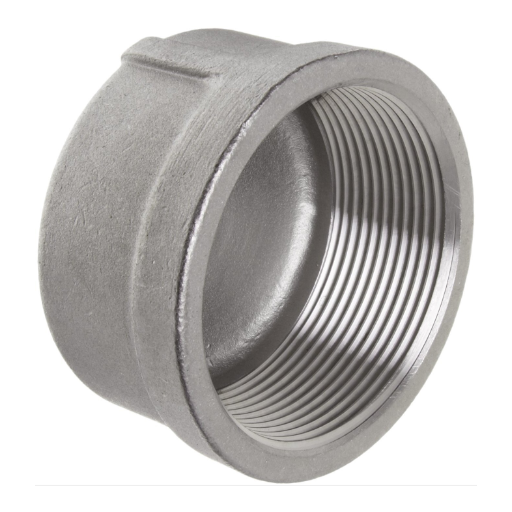
Steel end caps come in several common types based on shape and application:
- Round End Caps
Ideal for pipes and tubular structures, round caps provide a smooth, sealed finish. They are frequently used in industrial and architectural frameworks.
- Square End Caps
Designed for square or rectangular tubing, these caps are often used in structural applications such as fencing or machinery.
- Weld-On End Caps
These caps are permanently welded to the ends of steel pipes or tubes, ensuring a durable seal suitable for high-pressure environments.
- Threaded End Caps
Equipped with internal or external threads, these caps can be screwed into place, making them reusable and convenient for applications requiring frequent access.
- Domed End Caps
These rounded caps are used when aesthetics are a concern or when additional pressure resistance is needed. They are common in decorative piping or specialized equipment.
Each type serves specific functional and aesthetic purposes, so selection depends on the project requirements and compatibility with the connected component.
Comparing tubing end caps and pipe fittings
Tubing end caps seal and protect pipe ends, while pipe fittings connect and redirect flow in piping systems.
| Key Point | Tubing End Caps | Pipe Fittings |
|---|---|---|
|
Purpose |
Seal pipe ends |
Connect pipes |
|
Material |
Steel, PVC, etc. |
Steel, brass, etc. |
|
Function |
Protection |
Flow redirection |
|
Installation |
Simple |
Complex |
|
Applications |
Storage, safety |
Plumbing, flow |
The role of railing end caps in metal structures
In metal framing systems, the designs of balustrade end caps and balcony end caps are critical. They cover the access exposed to last, sealing the edges of railings and stop any internal parts from getting dampened by external elements. More importantly, these serves a major purpose anywhere close to outdoors; where the delicate nature of metals is brought under attack.
Another advantage of the end caps is that they promote safety by cutting out a section of materials from the structure that might hurt the people using the structure. This is so much helpful where the services of a staircase, balcony or even walkways in public and commercial set up is concerned since there are usually requirements regarding sharp or rough areas boundaries.
Published information shows that out of the set of materials used for producing balustrade end caps, the main two constituents that are metal – stainless steel and aluminum have been the predominant ones. This constant use is due to the platelets’ surfaces being free from corrosion, low weight and simplicity of maintaining them in clean condition. If it drains internal constituents or kill corrosion prone area. For example, the imposing stainless steel bars have more than 505 MPa tensile strength, to 1000 MPa (depending on the grade), is adequate for load requirements of structural steel member as well as their appearance.
Such materials also come with endless design possibilities, divided into domed, flat, and decorative designs for their end caps. Such variety ensures a complete blending of the end-capped finish with various design styles of a building from ultra-modern to ultraclassic. Properly attaching fasteners will avoid the metal from early deterioration. Not only does this improve its appearance, it also prevents hazardous situations from cropping up within the design.
How to install steel end caps?
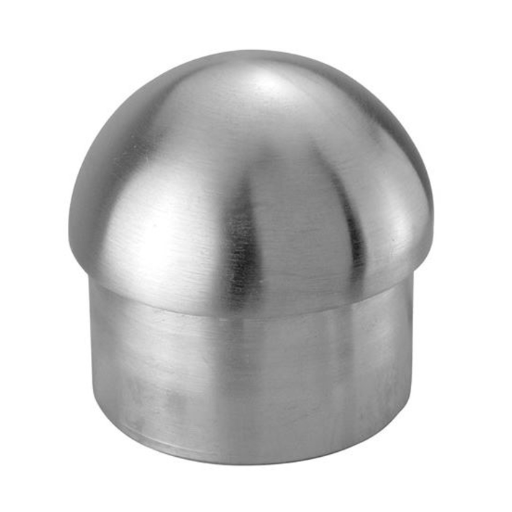
- Measure the Pipe or Tube
Ensure the steel end cap matches the diameter of the pipe or tube you are working with. Accurate measurements prevent loose or overly tight fittings.
- Prepare the Surface
Clean the end of the pipe or tube to remove any dirt, grease, or debris. This ensures a secure and proper fit.
- Align the End Cap
Position the steel end cap over the pipe or tube end. Ensure it is correctly aligned to avoid uneven installation.
- Secure the End Cap
Gently press or tap the end cap into place. Use a rubber mallet if needed, applying light force to avoid damaging the cap or pipe.
- Verify the Fit
Check the end cap to ensure it sits snugly and securely without gaps or wobbling.
Step-by-step guide for pipe and tubing
Measuring Pipe or Tube Length
Use a tape measure to measure the exact length of the pipe or tube that meets the requirements of your project. This will help you to prevent any material wastage by ensuring that the measurements are accurate and that the fittings fit perfectly.
Cutting the Pipe or Tube
Take the proper precautions and make use of appropriate tools such as a hacksaw or power saw or a tube cutter and cut the pipe or tubing onto proportions that you need. To cut a pipe ‘in’ number of time and achieve the same cutting tool considered to make the cut may be at an angle restricts its usage as it will fail to achieve the desired bore diameter of the cut pipe
Debur the Bottom parts
After cutting, remove any burrs or sharp edges with the aid of deburring tools, sandpaper, or a file. These steps facilitate closer joints, thereby preventing any harm to any pipe fittings and resistant seals.
Clean the Surface
Use a dry rag or a solvent to cleanse the pipe or tubing surface. It gets rid of dirt, oil, or even other foreign materials that would prevent a good connection.
Select Fittings
Depending on the specific requirements for the projects, select a fitting that will work with the material and size of the pipe or tubing. Make sure fittings are conform to the safety standards of the Industry to promote durability and efficiency.
Try a Dry fit again
The trial fit of all the components should be done to ensure the final dimensions of the assembly are in place before applying any adhesive or sealant. Make necessary adjustments for the perfect fit.
Apply Sealant or Adhesive (if deemed necessary)
In the event of a water-holding installation, it is necessary to take more steps like applying adhesives or sealants or even Teflon tape in the ends of the pipe or tube. The application and curing time must follow the manufacturer’s recommendations.
Put the Parts Together
The pipe or tubing has to be put together to the fittings or joints very cautiously. Sit the pipe together (push or screw fit) or joints ensuring the reliability of connection.
Make sure Joints are Tightened
For properties like tightness of joints use tools like spanners that produce tension or crimping kind of tools as and when necessary. Do not overstrain it as it could break the parts.
Check the Assembly
Look to see if everything has been put in the correct spot, if the connections are fitting well with one another and most importantly, if there are any leaks or spaces. Look to make corrections in case there are any issues.
Test the Pressure working System
Determine how much pressure can be handled without causing leakage or collapsing the system. Pay close attention to the setup at all times and address every problem at its onset.
Finalize the Setup and Tidy UP
Once the system is evaluated and found to be working, anything such as the excess caulk, adherence paper that is still present; or dust or other debris needs to be cleaned. Double check that the installation is compliant with the scope of work and the safety regulations involved.
In this way, by following the above measures you can guarantee an accurate installation of pipe and tubing systems which would further assure its effectiveness. Consider also the necessary product specific requirements to maximize the best results.
Tools required for fitting end caps
Fitting end caps requires a combination of precise tools to ensure a secure and lasting installation. Here’s a breakdown of the essential tools and their specific roles:
- Pipe Cutter or Hacksaw
A high-quality pipe cutter or hacksaw is necessary for cutting the pipe to the desired length before fitting the end cap. Ensure the tool provides clean and precise cuts to avoid uneven edges that might compromise the seal.
- Deburring Tool
After cutting the pipe, a deburring tool is essential to remove rough edges or debris. This ensures a smooth surface for the end cap to fit snugly and reduces potential wear and damage to the cap or pipe.
- Pipe Cleaner
Use a pipe cleaning brush or solvent to clean the interior and exterior of the pipe. A clean surface is critical for creating a strong bond or seal with the end cap.
- Measuring Tape
Accurate measurements are vital for ensuring the end cap fits properly. A high-quality measuring tape helps maintain precision throughout the preparation and fitting process.
- Sealant or Adhesive
Depending on the piping material and application, a compatible pipe sealant or adhesive is important for preventing leaks and securing the end cap in place. Ensure the product matches the pipe material, such as PVC solvent cement for PVC pipes.
- Wrenches or Pliers
Adjustable wrenches or pliers are often needed for tightening or adjusting fittings to secure the end cap firmly. These tools also assist with making small corrections during the installation process.
- Protective Gear
Safety goggles and gloves are essential to protect against debris, sharp edges, or chemical exposure during installation. Always prioritize personal safety while working with tools and piping materials.
Using these tools properly will ensure a durable and reliable seal, preventing leaks and enhancing the life of your piping system. Always match tools and materials to the project specifications for optimal results.
Ensuring a secure weld for metal end caps
Achieving a secure weld for metal end caps requires precision and adherence to proper techniques. Start by ensuring the surface of the metal is clean and free of contaminants such as grease, oil, or rust, which can weaken the weld. Use a high-quality wire brush or grinding tool to prepare the area effectively.
When choosing a welding method, TIG (Tungsten Inert Gas) welding is often recommended for its precision and ability to create clean, strong welds. MIG (Metal Inert Gas) welding is another popular option, especially for larger-scale projects requiring faster application. For optimal results, selecting the correct filler material is critical—it should match or complement the metal composition of the end caps and piping to avoid corrosion and maintain structural integrity.
Maintaining the correct temperature during the welding process is essential. Experts suggest that improper heat control can lead to defects such as warping, incomplete penetration, or cracks. For example, stainless steel generally requires a welding temperature range between 1,300°F and 1,600°F, depending on its alloy. Always refer to temperature guides tailored to your specific metal type.
Data also shows the importance of post-weld treatment. Processes like stress-relief annealing or mechanical polishing can help enhance durability by reducing internal stresses and improving surface smoothness, particularly in pressure-sensitive systems. Additionally, conducting a leak test, such as hydrostatic or air pressure testing, should be performed after welding to verify a secure seal.
By following these guidelines and leveraging the right tools and techniques, you can ensure that your metal end caps deliver performance and reliability across a wide range of applications. Quality controls at every step will safeguard against failures and extend the lifespan of your piping system.
How do stainless steel end caps enhance product longevity?
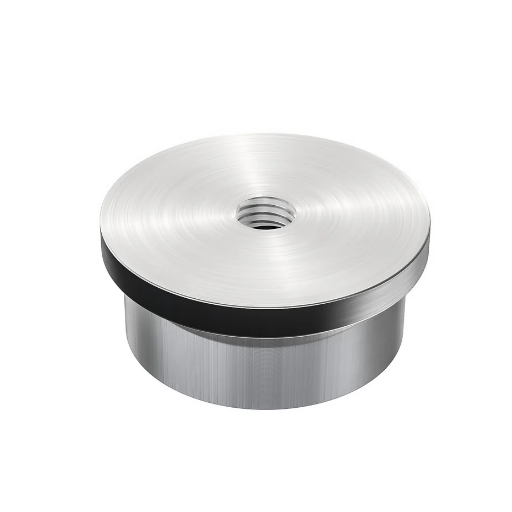
Stainless steel pressure vessel end caps have been knowm to prolong the life of the product with its immense capabilities of withstand pressure and maintain a its design for a long period of time. Public awareness, thus, is possibly the critical flowing factor to the effective use of the item such as preventing stainless steel corrosion from occurring, where mild steel does not work to prevent stainless steel flesh attack.
Corrosion resistance of stainless steel 316 and 304
Although in general both stainless steels stainless steel 316 and 304 have good resistance to rust, the former outperforms the latter, especially in tough environmental conditions. More severe applications may require the use of stainless steel 316 rather than 304. The latter resists corrosion quite well even under prevailing conditions therefore it would be suitable for most of the tasks. However, 316 has some amount of molybdenum explaining its greater resistance to chlorides and salt waters, and for that reason it is preferable for marine or chemical applications. The most appropriate steel will depend on the situation at hand but if it is for more severe conditions, I would go for the 316 steel minimising the rate of corrosion.
Impact of steel pipe end protection on wall integrity
Ensuring the pipe ends are safeguarded ultimately reduces risks to the surrounding materials and enhances the durability of the entire system. However, most of the damage and deformation to the pipe walls takes place during their transportation and storage. I have also found that using the protective caps or coatings helps in preventing the impacts and abrasions which can weaken the structural walls, or worst, suffer from long-term wear and tear.
Maintaining the outside diameter with pipe end caps
Pipe end caps have been used in may applications with the best one being to protect the pipe ends, which at times have been a requisite to the well kept already out of line outside diameter- which all today matters structural integrity and subsequent installation without a care. It is also worth noting the significance, other than size control, of using pipe end caps today taking into account such dire issues as extreme weather, temperature and physical stumbling blocks to avoid any on the pipe’s surface hence they are elastic and deformable and so the pipe will manage to remain resilient through the period of crating/storage/loader/unloader handling/tailboard-to-tailboard run.
Research also has shown that the adoption of expensively-made pipe end caps can be instrumental in cutting distortion rates by 25%. This area is of some crucial importance especially for a system where pipe alignment is critical for proper function, in many instances an even slightly oversized end diameter causes problems with fittings, increases the abandonment and misuse of worn out pipes or components. Due to its strength and relatively low rate of depreciating over time, such products are used by manufactures engaged in construction, oil and gas extraction, and plumbing among others.
In the same vein, installing end holes in pipes properly is a great way for industries to cut down on supply chain costs. By reducing the severity of physical damage and instances of repairs or replacements, calamity management becomes easier and therefore the business is able to avoid increased costs of maintenance as well as delays. It is imperative for the company’s top management to authorize and provide adequate resources regarding the protection of assets within the business in the short term so as to ensure the sustainability of the systems in a long run.
Reference Sources
- Stable 35-W Er: ZBLAN fiber laser with CaF2 end caps
- Authors: K. Goya et al.
- Publication Date: September 9, 2019
- Summary: This study presents a 2838 nm erbium-doped fluoride fiber laser with an average output power of 35 W, achieving continuous operation at 30 W for over an hour. The research focuses on the development of component technologies, including fiber Bragg grating fabrication and fine fusion splicing of fiber with end caps. The results indicate significant improvements in temporal and spectral stability, attributed to the optimized splicing process. The study highlights the potential for high-power laser applications in various fields, emphasizing the importance of end cap design in achieving stable performance(Goya et al., 2019).
- Electrostatic field enhancement on end-caps of cylindrical field-emitters
- Authors: S. Sarkar, D. Biswas
- Publication Date: November 1, 2019
- Summary: This paper investigates the apex field enhancement factor (AFEF) of cylindrical emitters with various end-cap geometries. The authors conduct a systematic numerical study to determine how changes in end-cap shape affect the AFEF while maintaining a fixed height-to-radius ratio. The study provides an approximate formula for AFEF based on measurable parameters, demonstrating that variations in end-cap geometry can significantly influence field emission current(Sarkar & Biswas, 2019).
- An End-to-End Steel Surface Defect Detection Approach via Fusing Multiple Hierarchical Features
- Authors: Yu He et al.
- Publication Date: April 1, 2020
- Summary: This research proposes a novel defect detection system for steel plate inspection, focusing on the role of end caps in the overall structure. The system employs deep learning techniques to achieve strong classification ability and combines multiple hierarchical features for improved defect localization. The study emphasizes the importance of accurate defect detection in maintaining the integrity of steel structures, including those with end caps(He et al., 2020, pp. 1493–1504).
Frequently Asked Questions (FAQs)
Q: What are steel end caps?
A: Steel end caps are protective covers used to seal the ends of tubes and pipes, preventing damage and providing a clean finish.
Q: How do I know which steel end caps fit my tube?
A: To ensure that the steel end caps fit your tube, measure the outer diameter of the tube and match it with the size specifications of the caps available. Most manufacturers provide size charts for compatibility.
Q: Are flat steel end caps better than rounded ones?
A: The choice between flat and rounded steel end caps depends on the application. Flat caps are ideal for applications requiring stability and stacking, while rounded caps are often used where aesthetics or fluid flow are considerations.
Q: What materials are steel end caps typically made from?
A: Steel end caps are typically made from carbon steel or stainless steel, providing durability and resistance to corrosion. The material choice depends on the environmental conditions and specific requirements of the application.
A: Yes, related products such as gaskets, clamps, and fittings may be necessary to ensure a secure and leak-proof connection. These items can enhance the performance and longevity of the steel end caps.
Q: How are steel end caps installed?
A: Steel end caps are installed by pressing or welding them onto the ends of pipes or tubes. The method depends on the application requirements, with welding providing a more permanent and secure fit.
Q: Can steel end caps be used for both indoor and outdoor applications?
A: Yes, steel end caps are suitable for both indoor and outdoor applications. However, for outdoor use, stainless steel caps are recommended due to their superior corrosion resistance.
Q: Are custom sizes of steel end caps available?
A: Custom sizes of steel end caps are available from many manufacturers. It’s advisable to contact the manufacturer directly to discuss specific requirements and ensure the best fit for your application.
Q: What are the benefits of using steel end caps?
A: Steel end caps offer several benefits, including protection of pipe ends, prevention of debris accumulation, and providing a finished look. They also contribute to safety by covering sharp edges.
Q: Do steel end caps come in different finishes?
A: Yes, steel end caps are available in different finishes, such as polished, brushed, or coated, to suit aesthetic preferences and application needs.



